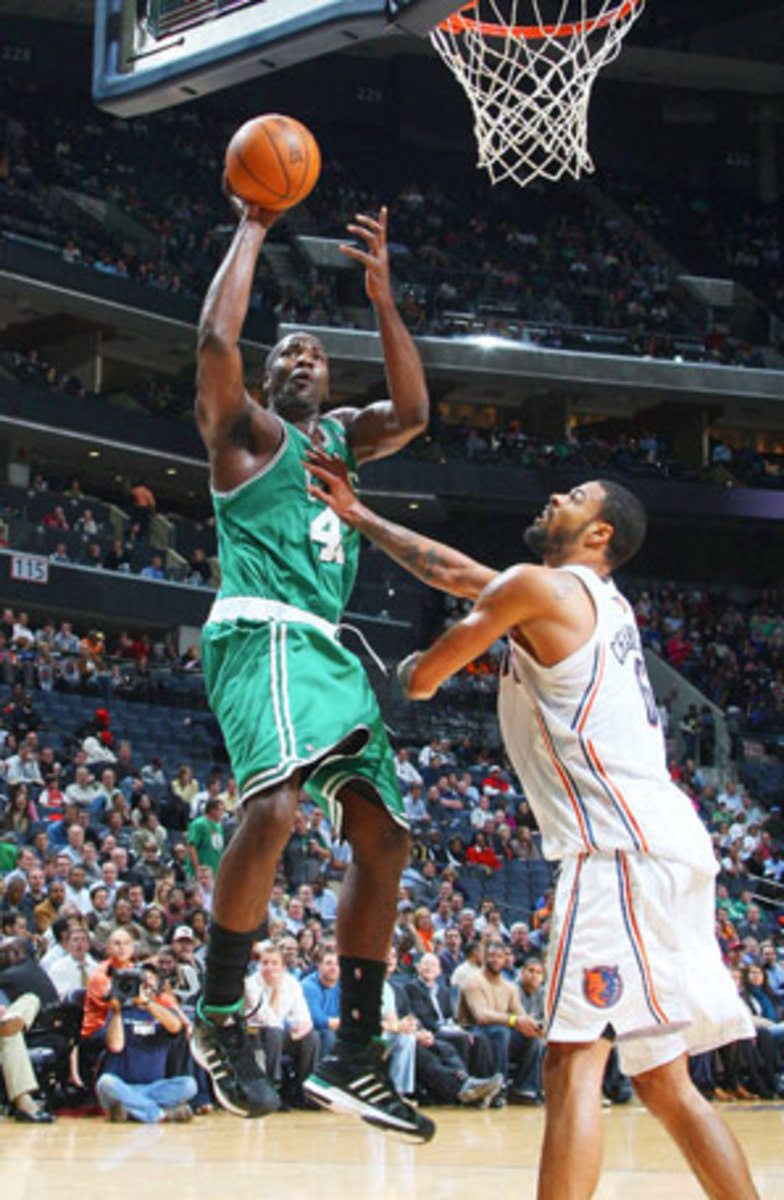Often overlooked, Perkins has become force for Celtics inside


Boston Celtics center Kendrick Perkins talks like he plays: with maximum efficiency and the delicacy of a sledgehammer.
"I'm a guy who never settles for a face-up jump shot. I'm going to get as deep in the post as possible," he said. "Some guys, even big guys, tend to settle. They spend the whole off season working on their outside game, trying to prove they can make that shot. I'm not one of those guys. Get to the rim: That should make sense to anybody."
That layup-or-bust philosophy explains why more than 80 percent of Perkins' field-goal attempts -- a remarkable 131 out of 152 shots -- are clustered in the tight area closest to the hoop. It also explains why the 25-year-old is the NBA's most accurate shooter at 65.1 percent and the rock in the Celtics' low-post defense.
His disdain for jump-shot practice provided Perkins a ready-made excuse for working on his speed this offseason, without sacrificing any strength. And his quickness showed prominently in a recent game at San Antonio, where Perkins raced over from his low-post assignment to twice deny a three-pointer by ManuGinobili in the corner. When Ginobili tried to go baseline, he was again met, and pressured, by Perkins. The missed shot was pulled down by Kevin Garnett and zipped to Rajon Rondo, who took two dribbles before hitting Perkins with a perfectly placed bounce pass for a layup.
Not bad for a 6-10, 280-pounder.
But the sideline close-outs and fast-break finishes are just the gravy in Perkins' game. The meat and potatoes are his staunch, stand-'em-up, low-post defense and his dexterity in guarding the pick-and-roll.
Perkins' mettle in the low block was validated by his yeoman effort in rooting Dwight Howard out of his favorite spots in last year's Celtics-Magic series in the second round of the playoffs. Unlike most players, Perkins doesn't use a forearm when guarding opponents who operate with their backs to the basket. "If you use the forearm, you don't have enough balance when they spin or fade away," he said. Instead, he uses hands for sensory information; the outside hand placed on an opponents' tailbone to determine where he's going (and, if possible, to guide him), while the inside hand stabs for steals.
Along with producing studier balance, this approach enables Perkins to provide resistance with an unyielding chest and trunk as the hands give way. It's a classic, albeit increasingly rare, style of bump-and-grind, low-post defense.
But Boston coach Doc Rivers cherishes Perkins' defense as much for his brains as his brawn. "[Assistant head coach] Tom [Thibodeau] does a terrific job getting our guys to communicate, but at the end of the day, Kevin and Perk are seeing things before they happen; they have such high basketball IQs and adjust to all the wrinkles," Rivers said. "The other thing that has happened to Perk to make him better is his focus. He accepts who he is and knows that his biggest value to the team is being our best defender."
Yes, even better than Rondo and Garnett.
Echoing what Rivers said about focus, Perkins leaves no doubt that the priority of both big men is defense, and more specifically, pick-and-roll defense. As a result of their commitment, the Celtics, as of Wednesday, lead the league in points-allowed per game (90.52), defensive efficiency (allowing just 99.0 points per 100 possessions, nearly a point better than second-place Charlotte) and in point-differential (+9.42). In a tie with Orlando, they also own the second-best overall record (17-4), behind the Lakers' 16-3.
When the Celts signed free agent Rasheed Wallace during the offseason, many assumed Perkins' playing time would plummet. But during Boston's current eight-game winning streak, Perkins' has averaged 30 minutes a game, a hair more than his 29.7 last season. Given Garnett's continued recovery from knee surgery, Wallace's less-than-stellar conditioning and Glen Davis' broken thumb, Perkins' reliability has been vital to the team's early success.
That's why statistics inadequately, or very subtly, measure Perk's worth. Sure he's scoring more from both the field and the line so far this season, but as Rivers points out, he's also setting much better picks, resulting in fewer offensive fouls, and is playing a major role in creating the league's second-best effective field goal percentage (which accounts for the added value of three pointers).
Add to that the intangibles -- "He plays with a chip on his shoulder ... that's different than [the trash-talking] with K.G.," said one scout, and "He's a role player, but he absolutely is part of any game plan you put together" said another -- and Perkins has clearly shown he's a needed figure among a starting corps saturated with bona-fide stars.
"Going into a game, everybody knows Garnett, and [Paul] Pierce and [Ray] Allen, and it is getting like that for Rondo, too," Perkins said. "My motivation is that as people leave the gym, they know Perkins."
